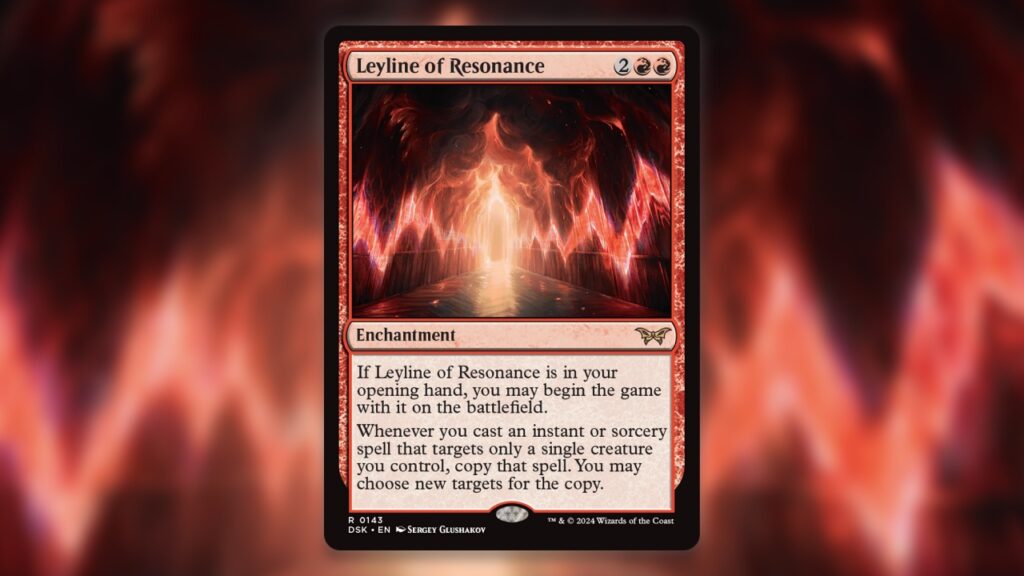Considering that Edge of Eternities ushered in rotation just a few days ago, there hasn’t been a lot of time for players to try out new Standard decks. Only one weekend has passed since rotation, and considering that was prerelease weekend for Edge of Eternities, many stores would be hosting that instead. Add on that Edge of Eternities’ digital release hasn’t happened yet, and playing post-rotation Standard is not an easy affair.
That said, there have already been a few Standard events played, and the winners from those events have sported some interesting decks. One of which heralds back to a card that was so powerful that it got banned in MTG Arena’s best-of-one Standard. Leyline of Resonance is back, and it’s looking as deadly as ever.
Leyline Aggro

For those who are unaware of how this deck, Leyline Aggro wants to start the game with a Leyline of Resonance in play. Then, it’ll use single-target instants and sorceries like Turn Inside Out to massively buff your creatures. After dealing massive damage, use Callous Sellsword‘s Adventure spell Burn Together to, essentially, Fling a buffed creature for massive damage to the opponent.
This deck plays a lot of aggressive creatures that synergize well with this strategy. Slickshot Show-Off, for example, can one-shot the opponent with the previous combo. Because Show-Off has Plot, you can even kill the opponent on the same turn you play the creature, making it harder to remove.
Many of the creatures this deck employs play well with this synergy, but perhaps none play better than the new Edge of Eternities uncommon Hemosymbic Mite. Mite’s attack trigger allows another creature to get buffs equal to its power. If you want to avoid putting all of your effects into one creature, the Mite can essentially make it so your combat tricks will buff two creatures. Many of the other creatures in this deck have Trample or some sort of evasion, making it difficult to block damage.
The other creatures present in this deck are all pretty self-explanatory. Questing Druid doubles as both a scaling threat that can use its Adventure spell to continually create gas. Valley Mightcaller and Pawpatch Recruit are both Trampling threats that can scale as the game progresses.
The rest of the deck is simply combat tricks that either buff your creature’s power, grant them Hexproof to dodge removal, or do both at the same time. Overprotect is a card we’ve been seeing a lot of since Monstrous Rage rotated out of Standard, and it’s practically the perfect buff spell for this deck. In addition to granting a massive +3/+3 stat boost, Overprotect grants Trample and Hexproof. This can easily end games when doubled with Leyline of Resonance.
Preparing for Slower Matchups

Similar to aggressive decks pre-ban, this Leyline Aggro deck wants to combine aggressive cards with a combo-esque finish to continually present lethal throughout the game. This variant of the deck, however, is a lot more fragile than the Mouse-based Mono-Red strategies. Many of the cards in the deck don’t function well without other pieces, mainly a trend shared by the surplus of combat tricks. This means some well-timed removal can cause this deck to completely stop functioning. The sideboard tries to remedy that somewhat. While it can’t fix the entire problem, it can make it better.
For matchups that require a bit more elbow grease, the deck can, basically, sideboard into a more midrangey gameplan. All of the cards in the sideboard do one of two things: prepare for a longer game or interact with strategies that can keep up with the speed of Gruul Leyline.
For slower threats, Screaming Nemesis and Sentinel of the Nameless City can come in and deal lasting damage over longer games. Sentinel can use Map Tokens to continually create value, while Screaming Nemesis is a lot more valuable as an individual threat than any of the maindeck ones.
Innkeeper’s Talent and Opera Love Song are two other cards that can play larger roles in slower games. Opera Love Song synergizes a bit awkwardly with Leyline of Resonance since, if you target two creatures, the enchantment won’t trigger. That said, the card is a better standalone one than many of the cards in the main deck, similar to Screaming Nemesis.
Innkeeper’s Talent, on the other hand, can naturally scale your creatures into bigger threats and can grant some smaller form of protection. The card, importantly, also dodges Ultima and the new Pinnacle Starcage, allowing you to continually present meaningful threats through board wipes.
All of that said, while Leyline Aggro can board in cards that work better on their own, it doesn’t entirely fix the issue. There are such a high number of cards, like the 14 combat tricks in the deck and the 4 Leylines, that need other cards to create value. Even with 5ish sideboard cards, the deck does remain fragile, just less so than usual.
Aggro is Always Best at the Beginning
In a new, undiscovered format, whoever manages to create the litmus test first is ahead. Decks aren’t prepared to play against specific strategies, and Leyline Aggro can take advantage of that. This should be a strong deck to start the format with, and winning a $5K teams event is a strong vouch for that.
This also means that, if Leyline Aggro continues to be the best aggro deck, as the format evolves, there will be a lot of preparation to beat it. Since this strategy is rather fragile, this may not play out too well. The likely result is that this strategy goes a little less all-in on the one-hit KO idea, and runs cards in the main deck that are individually powerful, like Screaming Nemesis.
That said, it will certainly take some time for the metagame to settle, and, for now, Leyline Aggro is one of the strongest decks out of the gate.


